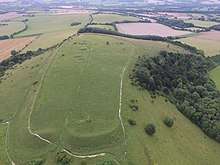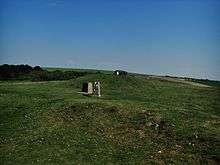Old Winchester Hill
 Iron Age hill fort | |
| Altitude | 130 m (427 ft) |
|---|---|
| Area | Hampshire |
| History | |
| Abandoned | Iron age |
| Site notes | |
| Excavation dates | Partly Excavated |
| Management | Natural England |
Old Winchester Hill is a chalk hill in Hampshire, England surmounted by an Iron Age hill fort and a Bronze Age cemetery. It is a Site of Special Scientific Interest and a National Nature Reserve. The hill fort has never been fully excavated.[1]

Location
Despite its name the hill is around 11 miles (18 km) from Winchester; it is however part of the Winchester-East Meon Anticline. It lies to the east of Corhampton on the eastern side of the Meon Valley, opposite Beacon Hill. The South Downs Way and Monarch's Way long distance footpaths cross the summit of the hill, which reaches 197 metres (646 ft). About 2 kilometres to the northeast is another prominent hill, Henwood Down (201 m), above the village of East Meon.
In March 2009, it became part of the South Downs National Park.
Archaeology

On the summit of the hill is an Iron Age hill fort. Within the hill fort can also be found Bronze Age barrows. The barrows date from between 4500 and 3,500 BCE whilst the fort itself is believed to be Iron Age in origin. It was probably built in the Early or early-Middle Iron Age (600-300 BCE) and fell out of use around the beginning of the Late Iron Age (150-100 BCE), as this is the general pattern for hillforts in the southeast of England. More modern archaeology dates from World War II when the British Army used the hill as a mortar testing range. Some unexploded Ordnance may still remain in 'fenced-off' sections of the hill however grazing hill-sheep access all areas so danger to the casual walker is likely to be low.[2]
Wildlife
The hill is the Site of Special Scientific Interest and a National Nature Reserve managed by Natural England. This unimproved chalk downland is home to a number of butterfly species, including the Adonis blue, chalkhill blue, common blue, dark green fritillary, Essex skipper, marbled white, meadow brown, silver-spotted skipper, small heath, small skipper, and the speckled wood. There is also a diverse bird population, including the European green woodpecker, commonly seen feeding amongst the many anthills (which are also very important for the lifecycle of the Lycaenidae butterflies) and the turtle dove. Many species of orchid can be found on the hill or in the immediate vicinity including the fly, bee and frog orchids.[1]
References
- 1 2 "Old Winchester Hill National Nature Reserve working today for nature tomorrow" (PDF). English Nature. 2003. pp. 1–4. Archived from the original (PDF) on 30 December 2008. Retrieved 2 October 2018.
- ↑ "Old Winchester Hill NNR". English Nature. 1998. Archived from the original on 25 December 2004. Retrieved 2 October 2018.
| Wikimedia Commons has media related to Old Winchester Hill. |